转载自:Top的color Net
.Net
概要:本文主要说明在.net(C#)中是如何也传统的COM和ActiveX进行交互的。其中包括:
1、 如何在.net中使用传统的COM及ActiveX?
2、 反之,如何让其它应用程序以传统的COM及ActiveX方式访问.net对象?也就是如何将.net对象以COM及ActiveX的形式暴露给操作系统。
3、 一些开发概要和示例,以及开发示例代码。代码只做演示与测试,不涉及细节问题。
第0部份:COM及ActiveX的简介
我不是COM高手,也不是ActiveX能人,对它们只是了解皮毛,所以为了防止读者对文章中的一些说明出现理解的偏差,有必要先说明一下本人对COM和ActiveX的理解。简单明了,COM和ActiveX都是不同的应用程序可以公用的组件。COM没有界面,而ActiveX是有界面的。ActiveX是特殊的COM。因此,COM所具有的功能,ActiveX都有,而ActiveX有更强大的功能及用户交界界面。本文不涉及COM及ActiveX的实现细节问题,主要是介绍把.net对象经COM的形式暴露给OS及其它应用程序的原理以及一些实现细节,而并非COM的开发细节。
COM是以组件的形式发布到目标机器上的,它可以被多个不同的应用程序公用。它是由操作系统的一个COM运行环境管理的(个人理解)。类似于.net运行环境,COM的运行环境负责整个COM的运行,从产生到结束。由于COM是MS在windows上较早的一个软件开发模式,而且COM是基于二进制的组件,所以目前基本上所有的windows平台上都可以使用COM,也就是不用担心你开发的COM不能在其它机器上使用了。(再次说明,完全是个人理解)
既然是操作系统管理COM的,当你开发一个COM时,必须让OS知道你开发的是什么COM,如何使用等一些必须的信息。相关的有关于COM的GUID,注册等一些 常见的知识。这里就不多说了。
我们所关心的问题之一是:当我的机上可以正常的使用COM时,如何让.net平台来使用传统的COM,当然也包括ActiveX.
第1部份:如何在.net(VS2003)下引用传统的COM及ActiveX
这是一个很简单的问题,想必很多读者都使用过,而我也不准备在这块上说很多。你可以通过引用,然后找到COM的注册文件,直接添加一个引用,然后像使用.net的对象一样使用经过引用后的COM。如果它是一个ActiveX,你还可以把它添加到工具栏上。当然,你的目标对象必须是正确的COM或者ActiveX。
那么经过引用后,它是如何工作的呢?其实我想讨论的,也就是传统的COM是如何在.net下工作的。看下面的图示(载自MSDN)
解释一下:
1、 首先就是把COM封装成程序集中的元数据,也就是.net可以使用的数据。VS2003给我们提供的工具是Tlibmp.exe,当你在引用COM时,VS2003就是用这个工具帮助我们把COM封装成了一个.net下可以用的元数据。也就是我们引用后,项目目录里会生成一个DLL文件,而它,就是.net可以使用的元数据。
2、 而在运行时,RCW会为我们处理一些细节问题,然后通过Interop来调用,你就像使用.net对象一样的使用COM。
我要说明的是:经过Tlbimp.exe封装后的元数据,只是在.net项目开发时使用的,运行时,真正的COM还是要在目标机器上安装注册。下面的一篇文章很有参考价值,读者可以深入的理解一下,.net是如何使用COM的。
http://www.microsoft.com/china/msdn/archives/library/dndotnet/html/bridge.asp
下面就是我们所关心的很二个问题,如何以COM的形式来访问.net对象?
第2部份,如何让其它应用程序以传统的COM方法来访问.net对象(原理)
请注意这里的措词,.net是不能开发传统的COM的。因此,一些关于.net开发COM以及ActiveX的说明都是不完全正确的。它的本质是把.net的对象,通过一些封装,然后暴露给操作系统,让其实的应用程序可以像传统的COM方式那样来访问.net对象,而访问该对象的同时,因为该对象只能在.net下生成,所以运行环境还是要.net支持的。
先看一下MSDN上的一个图示。
解释一下:
1. 托管代码经编译成中间语言,想必大家都明白。而让其它应用程序也可以访问你所编译的DLL文件,却有很多不同的方法。这里,就是一种,以COM的形式暴露给OS。
2. 这是技术核心,通过Tlbxp.exe工具,把DLL文件导出成组件(COM组件)类型库,也就是:把中间语言可以使用的DLL文件,通过工具,导出成COM可以使用的数据。
3. 注册,还有一个工具regasm.exe,可以把DLL向OS(注册表)以COM的形式注册对象。这样OS里的COM运行环境就知道系统里有一个对象,可以用GUID来标识并生成和使用。
4. 以COM的方式实例化.net对象,先是应用程序向COM运行环境请求,要以生成一个对象(GUID标识)。COM运行环境通过注册信息找到COM类型数据库,然后通过.net的CCW(COM Callable Wrapper)(COM可调用包装)来访问.net下的DLL文件,然后生成.net对象,再返回给COM运行环境。而COM运行环境再以COM的形式把.net对象返回给应用程序。然后应用程序就像访问COM一样的来访问.net对象。
因此,.net不能开发正真的COM,只是对.net对象进行一个封装,然后以COM的形式暴露给OS,让OS里的其它应用程序也可以像访问COM那样来访问.net对象。而本身的.net对象还是要.net环境来支持的。
好了,知道了它的原理后,我们就明白可以做什么事了。下面,我们就是如何来做事了。
第3部份,最简单的方法来暴露.net对象(VS2003)
这个方法很简单,就是做一个Library项目,然后把编译选项设定为Interop交互为true.
编译过后,系统会自动的为你在OS中注册一个COM,当然,有点类似ActiveX,就要看你的对象有没有界面了。
这里引用博客园里的另一文章给大家看看,应该有收获。
红马天下(http://www.cnblogs.com/homer/ )的这几篇文章:用C#编写ActiveX控件
http://www.cnblogs.com/homer/archive/2005/01/04/86473.html
http://www.cnblogs.com/homer/archive/2005/01/08/88780.html
http://www.cnblogs.com/homer/archive/2005/01/26/97822.html
上面的几篇文章里介绍了一些操作细节,我这里就不重复了。上面的工作大部份都是系统自动给我们完成的,下面我们来讨论一些细节问题。
第4部份:以传统的COM方式向OS暴露.net对象(VS2003下的操作及实现)
1、 还是new一个Library项目。
2、 添加一个COM对象(要安装插件,后面有下载):
3、 看看这个插件为我们做了什么(代码):
 using
System;
using
System; using
System.Runtime.InteropServices;
using
System.Runtime.InteropServices;
 namespace
Webb.PublicCOM.TestCOM01
namespace
Webb.PublicCOM.TestCOM01

 {
{
 Events raised by your COM class#region Events raised by your COM class
Events raised by your COM class#region Events raised by your COM class //
// // TODO: Insert delegates for events raised by your class here.
// TODO: Insert delegates for events raised by your class here. //
// //public delegate void Event1Handler(int i, int j);
//public delegate void Event1Handler(int i, int j);
 [ Guid("6C656B6C-F101-4CC8-A7C4-B2296A0A715C"),
[ Guid("6C656B6C-F101-4CC8-A7C4-B2296A0A715C"), InterfaceType(ComInterfaceType.InterfaceIsIDispatch) ]
InterfaceType(ComInterfaceType.InterfaceIsIDispatch) ] public interface IWebbTestCOM02Events
public interface IWebbTestCOM02Events

 {
{ //
// // TODO: Insert event handlers for events your class raises here.
// TODO: Insert event handlers for events your class raises here. //
// //[DispId(1)] void Event1(int i, int j);
//[DispId(1)] void Event1(int i, int j); }
} #endregion
#endregion

 Interface published by your COM class#region Interface published by your COM class
Interface published by your COM class#region Interface published by your COM class [ Guid("BE268E05-CF9C-43B4-986E-720971A924A2"),
[ Guid("BE268E05-CF9C-43B4-986E-720971A924A2"), InterfaceType(ComInterfaceType.InterfaceIsDual) ]
InterfaceType(ComInterfaceType.InterfaceIsDual) ] public interface IWebbTestCOM02
public interface IWebbTestCOM02

 {
{ //
// // TODO: Insert functions your class publishes here.
// TODO: Insert functions your class publishes here. //
// //[DispId(1)] int Function1(string s1, string s2);
//[DispId(1)] int Function1(string s1, string s2); }
} #endregion
#endregion
 [ Guid("B303E55E-F40A-4E8C-B94B-BE781E01274C"),
[ Guid("B303E55E-F40A-4E8C-B94B-BE781E01274C"), ProgId("Webb.PublicCOM.TestCOM01.WebbTestCOM02"),
ProgId("Webb.PublicCOM.TestCOM01.WebbTestCOM02"), ClassInterface(ClassInterfaceType.None),
ClassInterface(ClassInterfaceType.None), ComSourceInterfaces(typeof(IWebbTestCOM02Events)) ]
ComSourceInterfaces(typeof(IWebbTestCOM02Events)) ] public class WebbTestCOM02 : IWebbTestCOM02
public class WebbTestCOM02 : IWebbTestCOM02

 {
{ //
// // TODO: Insert events raised by your class here.
// TODO: Insert events raised by your class here. //
// //public event Event1Handler Event1;
//public event Event1Handler Event1;
 // A COM class must have a public parameterless constructor.
// A COM class must have a public parameterless constructor. // Otherwise the class might not be registered for COM and
// Otherwise the class might not be registered for COM and // cannot be created by CreateObject.
// cannot be created by CreateObject. public WebbTestCOM02() : base()
public WebbTestCOM02() : base()

 {
{ }
}
 //
// // TODO: Implement the methods of your class interface here.
// TODO: Implement the methods of your class interface here. //
// //public int Function1(string s1, string s2)
//public int Function1(string s1, string s2) //{
//{ // return 0;
// return 0; //}
//} }
} }
}
4、 删除一些注释的代码,编译项目,你就可以得到一个已经向OS暴露过的.net对象了。当然,你还可以添加一些函数或者事件。编译过后,有一个DLL文件,还有一个tlb文件,它就是用工具导出后,向COM暴露的组件库数据。C++可以用该文件通过COM方式来访问.net对象,注意,这与C++写托管代码完全不同。源代码有一个用C++通过COM来访问.net对象的实例。
5、 用其它应该程序来访问上面的对象。
我们的目标很明确,就是以COM的方式来访问前面的.net对象,首先你可以在COM对象里找到我们编译过和注册过的对象:
如果你是在.net下引用该COM,你会得到一个错误:
这里说明两个问题:
i. 我们在vs.net2003下添加COM引用时,其实就是我第1部份里说的原理,而这里我们所引用的对象本身已经是.net对象,所以再引用时,是会出错的。这里是引用,不是运行时创建。
ii. 我们可以直接对DLL文件引用,这与一般的.net程序集引用是有一点区别的:
可以看到,我们引用后的对象,与一般程序集的引用不一样,反而也COM的引用很像。也就说,我们这里的引用是通过了RCW的。
接下来,你就可以自由的把你的.net对象写的很完善了。大家应该可以注意到,我们写这个项目的时候,就是要遵守一些开发原则。因为COM的特殊性,我们的对象必须定义和实现一些接口,而在每种开发语言里,它的实现方法是不一样的。本文暂时不讨论代码实现细节,示例代码里有一个例子,可以参考一下。
第5部份:以ActiveX方式向OS暴露.net对象(VS2003下的操作及实现)
接上面的思路,我们应该可以想到,以COM方式向OS暴露.net对象,就是让我们的对象实现一些接口,定义一些必须信息。然后利用工具向OS注册这些信息就行了。下面讨论的就是,我们手动的修改和添加一些信息,让我们的.net对象实现更多的接口,然后以ActiveX的形式暴露给OS。首先说明,ActiveX是有页面的,因此我们可以从一个UserControl上开发。
在原来的项目中,添加一个TestActiveX01对象,从UserControl继承。然后给我们的对象添加一些特殊功能,让它以ActiveX的形式暴露给OS:
 using
System;
using
System; using
System.Collections;
using
System.Collections; using
System.ComponentModel;
using
System.ComponentModel; using
System.Drawing;
using
System.Drawing; using
System.Data;
using
System.Data; using
System.Windows.Forms;
using
System.Windows.Forms;
 //
Add in these using clauses for this example
//
Add in these using clauses for this example
 using
System.Runtime.InteropServices;
using
System.Runtime.InteropServices; using
System.Text;
using
System.Text; using
System.Reflection;
using
System.Reflection; using
Microsoft.Win32;
using
Microsoft.Win32;

 namespace
Webb.PublicCOM.TestCOM01
namespace
Webb.PublicCOM.TestCOM01

 {
{
 /**//// <summary>
/**//// <summary> /// Summary description for TestActiveX03.
/// Summary description for TestActiveX03. /// </summary>
/// </summary> [ProgId("Webb.PublicCOM.TestActiveX03")]
[ProgId("Webb.PublicCOM.TestActiveX03")] [ClassInterface(ClassInterfaceType.AutoDual)]
[ClassInterface(ClassInterfaceType.AutoDual)] public class TestActiveX03 : System.Windows.Forms.UserControl
public class TestActiveX03 : System.Windows.Forms.UserControl

 {
{ private System.Windows.Forms.PictureBox pictureBox1;
private System.Windows.Forms.PictureBox pictureBox1;
 /**//// <summary>
/**//// <summary>  /// Required designer variable.
/// Required designer variable. /// </summary>
/// </summary> private System.ComponentModel.Container components = null;
private System.ComponentModel.Container components = null;
 public TestActiveX03()
public TestActiveX03()

 {
{ // This call is required by the Windows.Forms Form Designer.
// This call is required by the Windows.Forms Form Designer. InitializeComponent();
InitializeComponent(); // TODO: Add any initialization after the InitializeComponent call
// TODO: Add any initialization after the InitializeComponent call }
}

 /**//// <summary>
/**//// <summary>  /// Clean up any resources being used.
/// Clean up any resources being used. /// </summary>
/// </summary> protected override void Dispose( bool disposing )
protected override void Dispose( bool disposing )

 {
{ if( disposing )
if( disposing )

 {
{ if(components != null)
if(components != null)

 {
{ components.Dispose();
components.Dispose(); }
} }
} base.Dispose( disposing );
base.Dispose( disposing ); }
}

 Component Designer generated code#region Component Designer generated code
Component Designer generated code#region Component Designer generated code
 /**//// <summary>
/**//// <summary>  /// Required method for Designer support - do not modify
/// Required method for Designer support - do not modify  /// the contents of this method with the code editor.
/// the contents of this method with the code editor. /// </summary>
/// </summary> private void InitializeComponent()
private void InitializeComponent()

 {
{ System.Resources.ResourceManager resources = new System.Resources.ResourceManager(typeof(TestActiveX03));
System.Resources.ResourceManager resources = new System.Resources.ResourceManager(typeof(TestActiveX03)); this.pictureBox1 = new System.Windows.Forms.PictureBox();
this.pictureBox1 = new System.Windows.Forms.PictureBox(); this.SuspendLayout();
this.SuspendLayout(); //
//  // pictureBox1
// pictureBox1 //
//  this.pictureBox1.Image = ((System.Drawing.Image)(resources.GetObject("pictureBox1.Image")));
this.pictureBox1.Image = ((System.Drawing.Image)(resources.GetObject("pictureBox1.Image"))); this.pictureBox1.Location = new System.Drawing.Point(0, 0);
this.pictureBox1.Location = new System.Drawing.Point(0, 0); this.pictureBox1.Name = "pictureBox1";
this.pictureBox1.Name = "pictureBox1"; this.pictureBox1.Size = new System.Drawing.Size(128, 40);
this.pictureBox1.Size = new System.Drawing.Size(128, 40); this.pictureBox1.TabIndex = 0;
this.pictureBox1.TabIndex = 0; this.pictureBox1.TabStop = false;
this.pictureBox1.TabStop = false; //
//  // TestActiveX03
// TestActiveX03 //
//  this.Controls.Add(this.pictureBox1);
this.Controls.Add(this.pictureBox1); this.Name = "TestActiveX03";
this.Name = "TestActiveX03"; this.Size = new System.Drawing.Size(200, 152);
this.Size = new System.Drawing.Size(200, 152); this.ResumeLayout(false);
this.ResumeLayout(false);
 }
} #endregion
#endregion

 /**//// <summary>
/**//// <summary> /// Register the class as a control and set it's CodeBase entry
/// Register the class as a control and set it's CodeBase entry /// </summary>
/// </summary> /// <param name="key">The registry key of the control</param>
/// <param name="key">The registry key of the control</param> [ComRegisterFunction()]
[ComRegisterFunction()] public static void RegisterClass ( string key )
public static void RegisterClass ( string key )

 {
{ // Strip off HKEY_CLASSES_ROOT\ from the passed key as I don't need it
// Strip off HKEY_CLASSES_ROOT\ from the passed key as I don't need it StringBuilder sb = new StringBuilder ( key ) ;
StringBuilder sb = new StringBuilder ( key ) ; sb.Replace(@"HKEY_CLASSES_ROOT\","") ;
sb.Replace(@"HKEY_CLASSES_ROOT\","") ; // Open the CLSID\{guid} key for write access
// Open the CLSID\{guid} key for write access RegistryKey k = Registry.ClassesRoot.OpenSubKey(sb.ToString(),true);
RegistryKey k = Registry.ClassesRoot.OpenSubKey(sb.ToString(),true); // And create the 'Control' key - this allows it to show up in
// And create the 'Control' key - this allows it to show up in // the ActiveX control container
// the ActiveX control container RegistryKey ctrl = k.CreateSubKey ( "Control" ) ;
RegistryKey ctrl = k.CreateSubKey ( "Control" ) ; ctrl.Close ( ) ;
ctrl.Close ( ) ; // Next create the CodeBase entry - needed if not string named and GACced.
// Next create the CodeBase entry - needed if not string named and GACced. RegistryKey inprocServer32 = k.OpenSubKey ( "InprocServer32" , true ) ;
RegistryKey inprocServer32 = k.OpenSubKey ( "InprocServer32" , true ) ; inprocServer32.SetValue ( "CodeBase" , Assembly.GetExecutingAssembly().CodeBase ) ;
inprocServer32.SetValue ( "CodeBase" , Assembly.GetExecutingAssembly().CodeBase ) ; inprocServer32.Close ( ) ;
inprocServer32.Close ( ) ; // Finally close the main key
// Finally close the main key k.Close ( ) ;
k.Close ( ) ; }
}

 /**//// <summary>
/**//// <summary> /// Called to unregister the control
/// Called to unregister the control /// </summary>
/// </summary> /// <param name="key">Tke registry key</param>
/// <param name="key">Tke registry key</param> [ComUnregisterFunction()]
[ComUnregisterFunction()] public static void UnregisterClass ( string key )
public static void UnregisterClass ( string key )

 {
{ StringBuilder sb = new StringBuilder ( key ) ;
StringBuilder sb = new StringBuilder ( key ) ; sb.Replace(@"HKEY_CLASSES_ROOT\","") ;
sb.Replace(@"HKEY_CLASSES_ROOT\","") ; // Open HKCR\CLSID\{guid} for write access
// Open HKCR\CLSID\{guid} for write access RegistryKey k = Registry.ClassesRoot.OpenSubKey(sb.ToString(),true);
RegistryKey k = Registry.ClassesRoot.OpenSubKey(sb.ToString(),true); // Delete the 'Control' key, but don't throw an exception if it does not exist
// Delete the 'Control' key, but don't throw an exception if it does not exist k.DeleteSubKey ( "Control" , false ) ;
k.DeleteSubKey ( "Control" , false ) ; // Next open up InprocServer32
// Next open up InprocServer32 RegistryKey inprocServer32 = k.OpenSubKey ( "InprocServer32" , true ) ;
RegistryKey inprocServer32 = k.OpenSubKey ( "InprocServer32" , true ) ; // And delete the CodeBase key, again not throwing if missing
// And delete the CodeBase key, again not throwing if missing k.DeleteSubKey ( "CodeBase" , false ) ;
k.DeleteSubKey ( "CodeBase" , false ) ; // Finally close the main key
// Finally close the main key k.Close ( ) ;
k.Close ( ) ; }
} }
} }
}

编译,然而用Active Control Test Container 来测试和查看我们的ActiveX:
可以看到,经过特殊方法实现后的对象可以在ActiveX中查看的到,而且可以添加到容器中:
接下来的工作就是一些功能的实现细节问题了,本文暂时不讨论这些内容。
最后一个问题就是在其它语言中通过COM来访问我们的.net对象,我们在C++下经过测试并实现了一些细节问题,事件等。但源代码不在示例中。
总结:.net开发COM或者ActiveX,其实是把写好的.net对象(当然是准备暴露给OS的),实现一些特殊的接口,通过工具把元数据导出成COM可用的组件库数据,然后注册给OS。运行时,通过CCW来动态的管理与维护.net对象。而对于用户来说,他就像访问COM一样访问.net对象。
MSDN参考:
http://msdn2.microsoft.com/zh-cn/library/8bwh56xe(VS.80).aspx
http://msdn2.microsoft.com/zh-cn/library/e753eftz(vs.80).aspx
下载文档:
1、 VS2003COM开发插件。
http://www.cnblogs.com/Files/WuCountry/CSComSetup.zip
2、 示例项目代码。
http://www.cnblogs.com/Files/WuCountry/Webb.PublicCOM.zip
3、 本文doc文档。
http://www.cnblogs.com/Files/WuCountry/TempDoc.zip








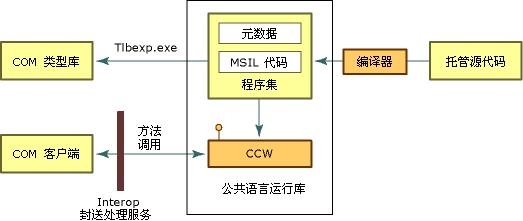
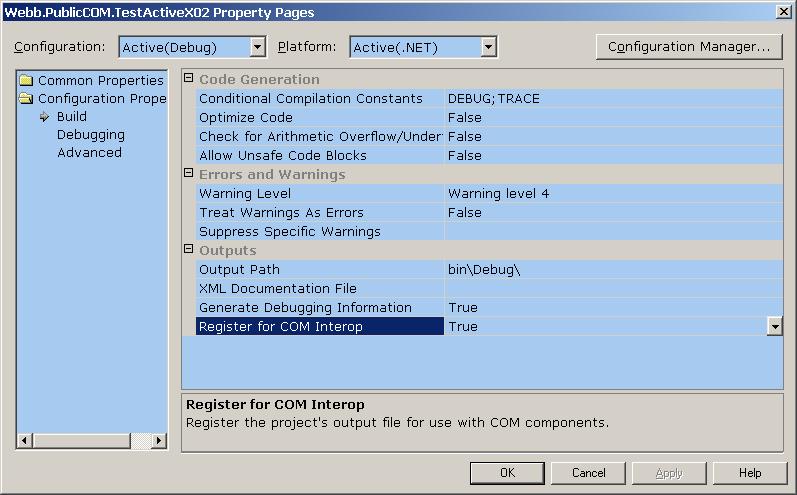

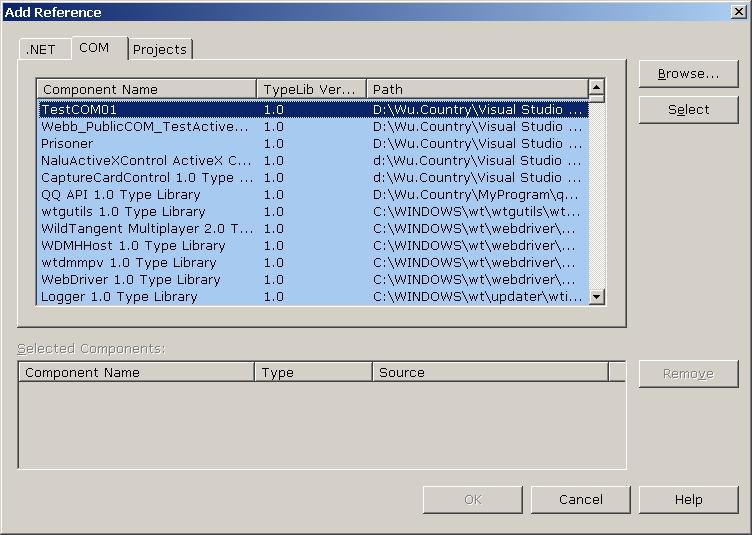


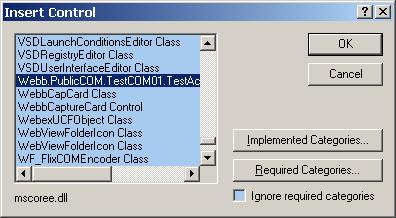
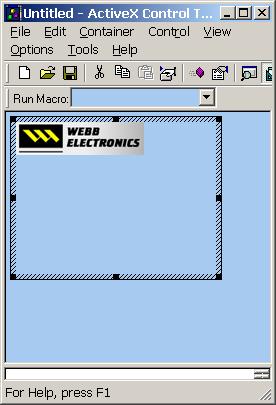














 887
887

 被折叠的 条评论
为什么被折叠?
被折叠的 条评论
为什么被折叠?








